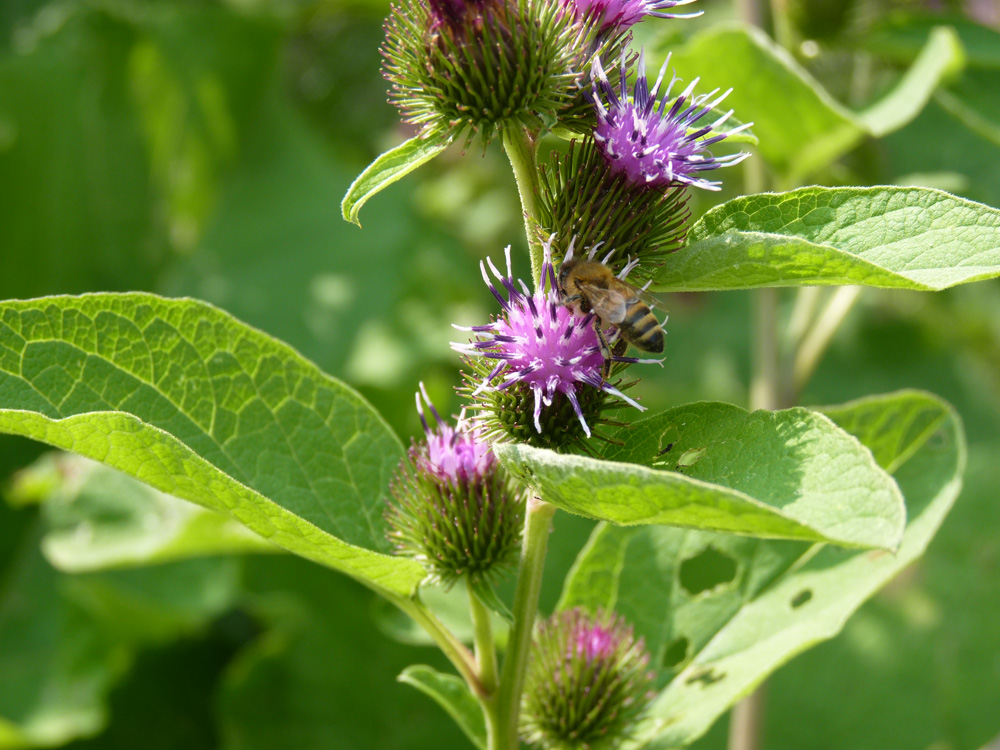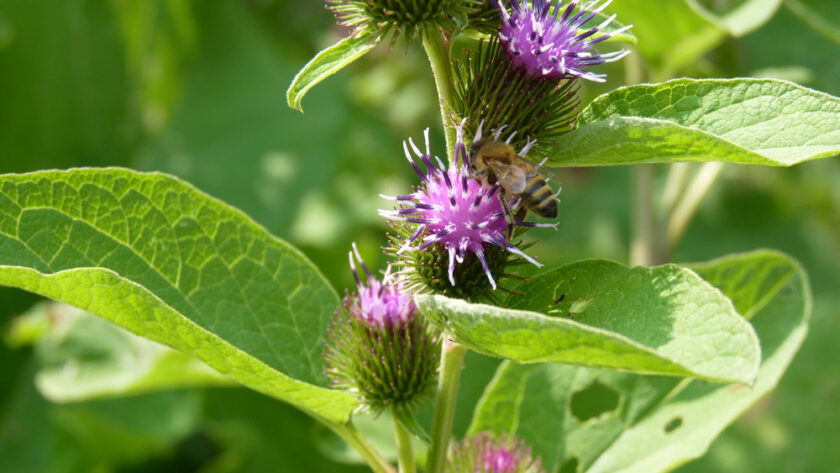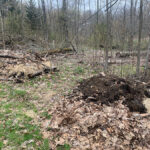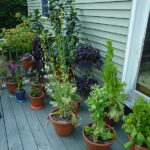As I grow ever more in tune and aware of nature’s gifts, I keep coming back to one of the tragedies of our age–our incredible misunderstanding of the natural world, the sacred living earth from which all things flow. One of the things I’ve been working hard to do in this blog, and in my own community here in PA, is to restore and reconnect humans and nature. My particular way of doing it has lately been through the teaching of healing plant medicine, edible wild foods, and the like. This means breaking down some assumptions, but really, building new knowledge and empowerment for many people in the community. Since moving to my small town I’ve been really busy as an ambassador offering presentations on permaculture and vermicomposting, summer plant walks (wild food/medicine), herbalism classes, and most recently I am teaching children at the local UU church how to make medicine from plantain! I am finding that here, there is a great need for this kind of plant education in the community, certainly, and great interest.
What I am learning is that people have very limited vocabularies, frameworks, and understandings when it comes to plants. One of the things that often comes up from people, and that they latch onto, is the idea of the “invasive” vs. “native” plant. When I share a plant, they want to know if its invasive or native, and I rarely want to use those terms. As I mentioned in my last post on this subject (which was rather controversial), the concept of invasiveness is, in itself, a real problem. And I think, more than anything, it is because all invasive plants are put into a little box. If these plants were human, attaching such a label would be considered racist, sexist, classist, homophobic, etc. But apparently, we can do it as much as we like to plants–and when we pigeonhole plants into an “invasive” or “native” category, we make assumptions about them without knowing their true nature, understanding their spirits, or their medicine and magic.

I think this is a problem for a number of reasons. For one, the term is derogatory and makes a set of assumptions that simply don’t fit for all plants within the “invasive” category. Second, a lot of plants don’t fit in the whole binary very well. Poison ivy, which is one of my very favorite plants (I will have to write on it one of these days) is a native plant, yet, it doesn’t get privileged status because humans don’t like what happens when they rub up against it. Water hemlock is another native plant that you do not want to tango. Nearly all lawn grass isn’t native, but humans like it because it mows well and mats well, and creates lawn. We have all kinds of stuff we’ve planted (hello wheat, oats, barley, lettuce, onion, radish, leek….the list goes on and on). How do any of these fit within the categories? They really don’t.
So if the categories don’t fit, why do we still use them? Probably because they are simple, and they allow people to know something (e.g. plant = good or plant = bad) about the plants. Part of what I believe we need to do, in order to build more fruitful relationships with nature, is to rethink these terms. So today, I’d like to present one new category that we can consider as a thinking, teaching, and relationship-building tool: the first aid responder plant.
Introducing: The First Aid Responder Plants
Imagine that a person who is in a really bad accident, that the person was unable to move, damaged and broken. Who would that person want to come to their aid? A first responder, that’s who! An ambulance and medic, someone who could help stabilize the person, get them to the hospital, and set them on the path for long-term healing and recovery.
If we use this same analogy with plants, we can see that this is what happens to our lands every day. I wrote about different kinds of damage extensively in my recent land healing series. Our lands are harmed by our various activities: oil extraction, logging, new construction, conventional agriculture, and so on. These activities really harm certain kinds of plant species that are slow to propagate and slow to take hold. But other plant species, those that have evolved to adapt to these kinds of conditions, can take hold and help regenerate the land. They are plants that are adapted to particular circumstances: disturbance and the nature of that disturbance is almost always human-caused, directly or indirectly. And these are our first responder plants.
Unfortunately, a lot of our first aid responders end up on noxious weed lists for a simple reason–they are abundant, as disturbance is abundant. This has people assume immediately that these plants are somehow “out of control” but, given the nature of where these plants grow, they are only responding to human-caused disturbance. As I’ll show here, the situation is far less clear. For one, people only pay attention to what is happening at this moment, not what has happened or what will happen in the future. This short-term view means that we cannot account for most of the variables in why the responder plants are here–and that’s a problem for a few reasons.
Ox-Eye daisy is a very good example of a first-aid responder plant (and delicious edible and medicinal plant). This plant often shows up in disturbed soil: over-grazed pastures, old potato fields, edges of parking lots, and so on. People see these dense patches of daisy and think, “oh noes! There’s the invader!” without paying attention to why it is growing there or the history of the land. I observed a very interesting pattern with regards to daisies in my own acre-sized field on my homestead: the first year, the field was all daisies, as the previous owners mowed the field all the time. I chose not to mow the field but instead only mow walking paths; the second year, the daisy only grew on the paths where I had mowed. By the fourth year, there were very few ox-eye daisies other than growing out of the paths–the rest of the field had gone to milkweed, st. john’s wort, wild strawberry, and other such plants. The truth is, you aren’t going to get rid of Ox-Eye daisy in a field–but you don’t need to if you let it do its sacred work of healing.

Sweet clover is another one where I’ve seen a similar pattern–areas of disturbance, especially areas that have been recently dug and mowed. I noticed this a lot in parks–fields of plants with sweet clover only on the disturbed edges. If there is no longer disruption, it disappears after about five years (fitting my first responder category). Bees make incredible honey from sweet clover, and it is also a fantastic medicinal plant, particularly indicated for nerve damage.
Dandelion is yet a third fantastic first responder plant; and I’ve written on the dandelion’s magic and purpose extensively a few years ago on this blog (along with wine recipes, lol). Dandelion breaks up compacted soil and brings nutrients from deep. It is particularly effective in regenerating lawns. Dandelions won’t grow once ecological succession happens and the lawn is no longer a lawn–again, they are a first responder plant. And, of course, dandelion is medicinal and edible.
Spotted Knapweed is yet another first responder, and one my herbal mentor Jim McDonald taught me extensively about. Jim showed us his field that used to be full of it. The more he pulled, the more it came (of course it did, it thrives in disturbance). He gave up pulling it out and over time, it did its work and now there isn’t hardly any of it left after about 10 years! And, if you are noticing the pattern here, spotted knapweed is also medicinal.
Curly Dock/Yellow Dock and Burdock, which are both fantastic medicinal and edible plants, also work with compacted soil well, and will grow to heal disturbance and break up compacted soil if given a chance to do so. Once ecological succession takes place, curly dock and burdock are nowhere to be found.

What you have hopefully noticed from this list is not only is this plant a first aid responder for the land, but these plants are also healing and medicinal for humans! We should be thanking them for the services we provide for our lands: healing the soil quickly and effectively, breaking up compacted soil, reducing erosion, offering us medicine and food so freely. These plants deserve our respect and to be honored. Where would the land be without these first aid responders? Where would we be without them?
I hope this framework is helpful to you as a way to expand beyond the invasive/native binary. Now, I am full to admit that this is one taxonomy of plants, and there is another group (kudzu, buckthorn) that may rightfully deserve some of the ire that people throw at them (as these vines literally tear down forests; the long-term ecological impacts still yet to be known). I cut buckthorn down by hand when I see it, for sure. But I don’t think by any means that the first responder plants deserve to be in the same category, not from all of my observations and research. And maybe, next time you see one, thank a first responder plant for the good work that plant is doing on behalf of all.
PS: This link tells you a bit more about how some first responder plants indicate certain soil conditions.




I love first responders. Nutrient accumulators. They not only heal soil but frequently heal people.
Yes, the dynamic accumulators are good at both of those things. They are pretty incredible!
Reblogged this on Reiki Dawn and commented:
Very cool article sharing
Thank you so much for the reblog, Dawn!
Loved the post Dana!
Reblogged this on Rattiesforeverworldpresscom.
Thank you so much for the reblog~
Sending much love to you Dana! This is so timely for me. I’ve been letting my yard grow whatever is there. Why do we need Kentucky Blue Grass in Montana, anyway?! We has a so-called “War on Weeds” here, which means that some public official was persuaded by a corporation to enter into a contract to buy and sell poison all over the land. This is also the state that allows cows to graze all over our public land, and thereby causing the weeds to grow in the first place. I’d like to wring their necks (not the cows, the humans), but instead, if we could ever get them to consider ideas like yours, it would be a blessing. Thanks so much for the work you do.
Crystal
Please overlook the typos! We HAVE, and buy and SPREAD. Thanks. c
Thank you Crystal. The war on weeds makes me very sad, for it is really a war on on nature’s response to our own behavior. I’m excited to hear more about what is already growing in your yard!
Mugwort and mullein were the primary first responders on our land. Great article, as usual!
Great article, as usual!
I didn’t talk about either of those, but yes, for sure! What kinds of plants are living there now?
Now we also have smooth madder, St. John’s Wort, dock (of varying sorts), wild carrot, bind weed (lol), milkweed, bladder campion–the biodiversity has grown immensely in the four years I’ve been there.
Isn’t it amazing what happens when we just let nature be nature? I love it :). Ecological succession will happen and it will happen beautifully with the first responders
[…] via Embracing “First Aid Responder” Plants — The Druid’s Garden […]
I love your critique of the native and invasive binary.
Thank you :). I think its a good to critique most binaries, especially those that lead to someone’s profit and more harm to the land.